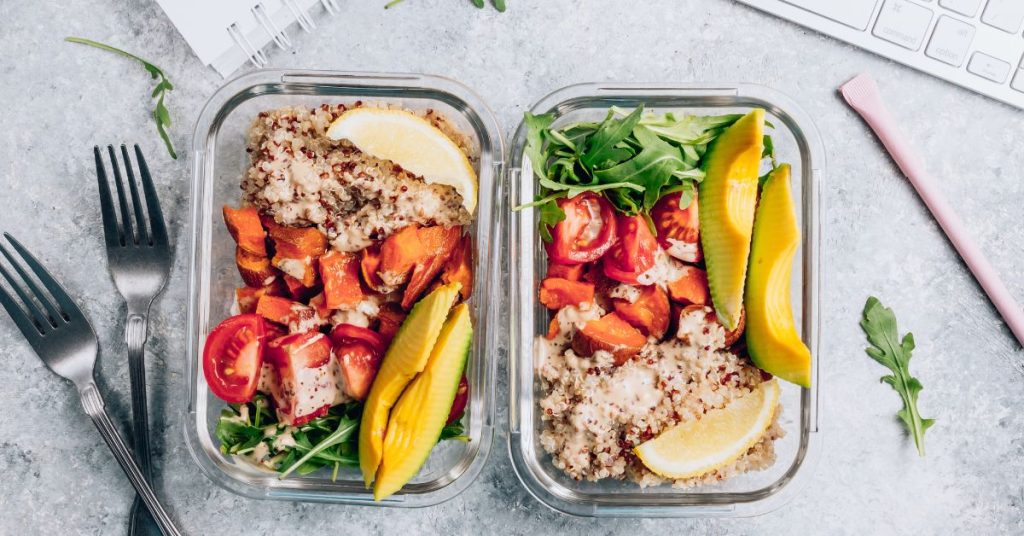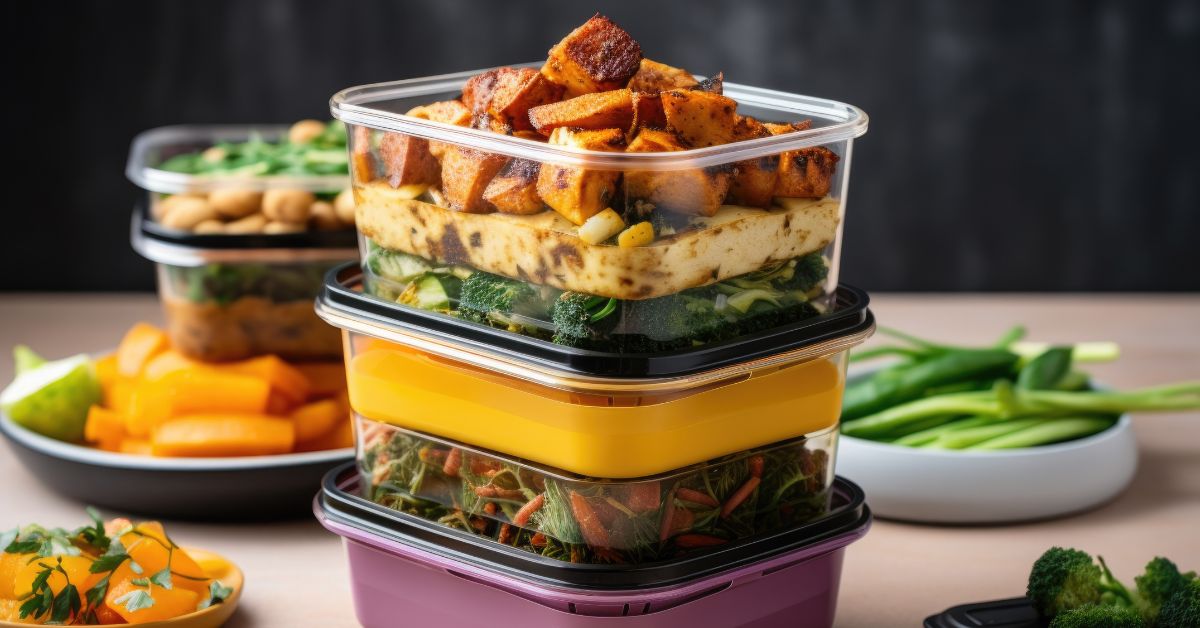

Many of us today feel constantly stretched thin, moving from one to-do list to the next, balancing work and family life, and often taking shortcuts when it comes to our health–especially with our diets. We may have the best intentions to eat whole plant-based foods at every meal, but when time is short at the end of a long, hectic day, we find ourselves reaching for whatever is quick and easy: junky fast food or store-bought frozen dinners. How can we avoid these common pitfalls? One of the best ways is to prepare healthy ingredients, snacks, and meals in large batches before we need them. This kind of preparation takes some planning and an upfront investment of time, but it saves time and money in the long run. And if you can stay well organized, you’re also less likely to waste food.
On those busy weekdays when you are tired or short on time, there’s nothing better than reaching into the fridge and grabbing some pre-cut fruit, a pre-cooked veggie burger, potatoes that you can quickly warm in a toaster oven, or a homemade bowl of soup that you can reheat in the time it takes to set the table. If the right ingredients are ready, you can also throw salads and power bowls together in just minutes. It just makes life so much easier! As a bonus, your grocery bill will be lower as you only stock up on items you need for your planned meals.
Here are some tips I have found useful:
1. Plan ahead
Before you head to the grocery store, make a menu for the week, then check your pantry and refrigerator to review what ingredients you are running low on. You may want to keep a list of all the ingredients you stock in your kitchen. Several convenient apps can help you do that. One of my favorites is AnyList. Paprika Recipe Manager is another of my favorite apps for storing recipes, making weekly menus, and compiling shopping lists.
2. Shop weekly
Weekly shopping ensures that your produce stays fresh and minimizes waste. It is also much easier to plan meals for seven days than for an extended period. Choose a day of the week to shop and schedule time for menu planning before then. For instance, you may shop on Friday and place everything inside the fridge until Sunday, when batch cooking and prepping is more convenient.
3. Find a system that works for you
There are many ways to plan your meals. Here are some popular ones:
a. Choose themes for each night – Monday could be Mexican Night, Tuesday Asian Night, Wednesday Italian Night, Thursday Burger Night, Friday Pizza Night, and so on.
b. Cook meals that can be combined with new ingredients – Monday’s chili might be used to top baked potatoes on Wednesday. Tuesday’s crispy lentil “bacon” might be used as a pizza topping on Thursday and as a power bowl ingredient for lunch on Friday. You could serve quinoa with veggies and beans one day and add it to your oatmeal or soup on another day. The possibilities are endless!

4. Our Favorite Foods to Batch Cook/Prep
a. Fresh, seasonal fruit
- Wash your strawberries, apples, pears, blueberries, raspberries, peaches, and grapes immediately before you consume them; washing fruit earlier may result in faster molding. One exception would be washing grapes before you freeze them. Frozen grapes are a popular snack in my home!
- Watermelons, cantaloupe, honeydew, pineapple, and mango are great examples of fruits you can cut up ahead of time and place in sealed containers.
- Freeze some of your ripe bananas! These are common in smoothies, “ice cream,” pancakes, and more.
b. A “Salad Bar” in your fridge
- Slice veggies and store them in containers. Carrots, cucumbers, bell peppers, scallions, and celery are great toppings for your salad or power bowls.
- Stock up on baby greens that are already pre-washed and ready to go.
c. Salad dressings – You can dress salads simply with a sprinkle of nutritional yeast, Italian herbs, and a vinegar of your choice. Alternatively, you can make and store your favorite dressings. My favorites include non-dairy caesar, ranch, miso ginger, and thousand island.
d. A big pot of soup – Soup is easy because everything goes into one pot. Switch it up and cook a different soup every week.
e. Chili – You can eat chili by itself, served over grains, on top of potatoes, over homemade baked tortilla chips, in a power bowl, etc.
f. “Burger of the Week” – Double or triple the recipe for a burger to enjoy easy meals all week. You can even freeze extras for a later time. (It is better to freeze them after you cook them so they don’t fall apart in the freezer.)
g. A large batch of grains – You can use brown rice, quinoa, millet, buckwheat, or wild rice to make soups, casseroles, bowls, and veggie burgers, or you can enjoy them with beans and veggies. Try cooking different types of whole grains a few times a week and freeze them for later use. This way, you always have them available for recipes.
h. A large batch of beans – Dried beans or lentils can be quickly cooked in an Instant Pot or pressure cooker. Try cooking a different type of bean a few times a week and then freeze them for later use so you always have them ready for recipes.
i. Baked potatoes – Scrub some potatoes and sweet potatoes and put them in the oven at 400°F to bake for about 30–40 minutes or until you can easily stick a fork in them. You can serve them with steamed veggies, leftover chili, or as a side dish. Or pack them as a snack when you are on the go!
j. Breakfast recipes – During the week, you may be too busy to stop and make a wholesome breakfast. If you make Sunday brunch, just double or triple the recipes to eat throughout the week. How about thinking outside the box and eating vegetables for breakfast?
5. Where to store my food?
a. Glass containers These are optimal storage containers for the refrigerator and freezer, allowing you to reheat your meals in the same container and minimize dishwashing. Before closing the container for storage, you may want to cover the food with parchment paper to prevent freezer burn.
b. BPA-free freezer bags These work great for freezing many different items. And you can wash and reuse bags to minimize waste.
c. Mason jars Jars are perfect for overnight oats, salads, or dressings and sauces.
d. Green bags These extend the life of refrigerated fruits and vegetables. Just be sure your produce is dry to prevent mold and remove the air from the bag before closing.
6. How Long Can You Store Various Foods?
a. Refrigerator – Cooked food stays fresh for about four days in the fridge.
b. Freezer – This depends on the type of food and your freezer. To avoid the dreaded “freezer burn,” don’t freeze your food longer than 2–3 months, and pack food tightly in containers so that there is minimal air space in the bag or bowl.
c. Special Instructions for Fruits:
- Always store fresh fruit separate from other produce; they can absorb odors from other foods and may also release ethylene, a gas that speeds the ripening of vegetables.
- Pears, apricots, nectarines, and mangoes may ripen at room temperature and then be stored in the refrigerator.
Food Storage Guidelines
| Food Item | Refrigerated (Unopened) |
Refrigerated (Opened) |
Room Temp (Unopened) |
Room Temp (Opened) |
Freezer |
| Apples | 3 weeks | 1 week | |||
| Blueberries | 1 week | 1 day | 1 year | ||
| Broccoli & Cauliflower |
1 week | ||||
| Citrus Fruits | 2 weeks | ||||
| Cooked Beans | 5 days | 3 days | 8 months | ||
| Cooked Rice | 6 days | 4 days | 6 months | ||
| Dark Leafy Greens | 5-7 days | 8 months | |||
| Garlic | 2 months | ||||
| Grapes | 5 days | ||||
| Herbs | 3 days | ||||
| Lemons & Limes |
3 weeks | ||||
| Lettuce | 5 days | ||||
| Melons | |||||
| Mushrooms | 1 week | ||||
| Onions | 2 months | 6 months | |||
| Plums | 5 days | ||||
| Potatoes | 3 weeks | ||||
| Quinoa | 1 week | 4-6 days | |||
| Strawberries | 3 days | 1 year | |||
| Tomatoes | 3 days | ||||
| Winter Squash | 1 week | 3 months |
***The shelf life of all produce depends on the variety, how ripe they were when picked, and how they were stored after picking and prior to distribution to the retail store or market.
Source: Boyer, Renee, and Julie McKinney. “Food Storage Guidelines for Consumers.” Virginia Cooperative Extension (2009): n. pag. Web. 7 Dec 2009.
Copyright 2025 Center for Nutrition Studies. All rights reserved.
Deepen Your Knowledge With Our
Plant-Based Nutrition
Certificate
Plant-Based Nutrition Certificate
- 23,000+ students
- 100% online, learn at your own pace
- No prerequisites
- Continuing education credits




